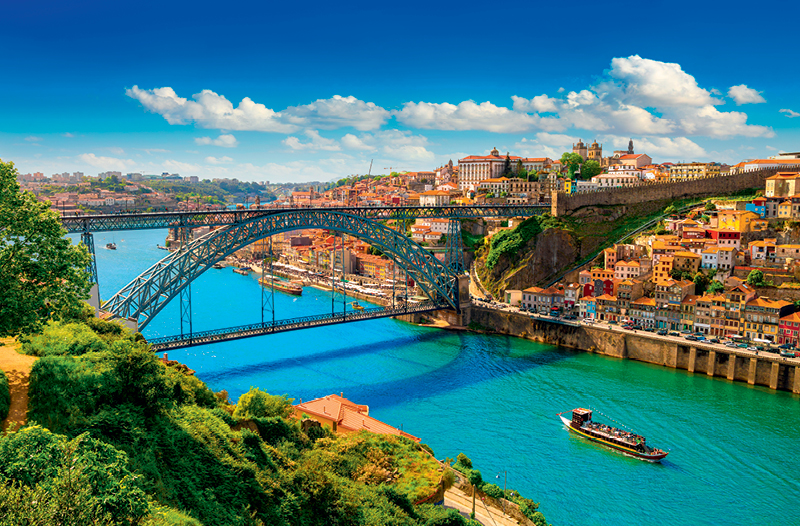
Forty Shades of Ireland

You can’t picture Ireland without thinking of the color green.
When to go Peak season—June to September—is peak for a reason: the weather is the best of the year, and the sun shines for an incredibly long time.
Currency Euro. €1 = US$1.07
Language A beautiful, lilting form of English, though Gaelic can often be heard throughout.
Companies to consider CIE Tours, Insight Vacations, Celebrity Cruises, Holland America Line
Even though Guinness is a dark amber, the Blarney Stone an oft-kissed gray, and the Cliffs of Moher a slate brown, it’s the rolling hills, forested valleys, and sheep-speckled fields framed by hedges that inspired Johnny Cash to describe Ireland as “Forty Shades of Green.”
The Emerald Isle is very green indeed, but it’s also much more than one color could ever describe. It’s an island filled with history and culture, with heartache and laughter. It’s a land of castles and ruins that are so common they are sometimes barely treated as attractions and offer few parking spaces for visitors. It’s a place to throw back a drink, trade stories with proud locals, and share in this adventure we call life. It’s easy to explore and hard to leave. Read on to give the green light to your wanderlust.

Start in Dublin
There are many ways to explore Ireland—by car or bus, foot or ferry—and nearly all of them begin in Dublin. This is both a blessing and curse. It’s a blessing because the country’s capital is about as charming as a city can be, a place where every trendy bar and traditional pub, every museum and boutique shop is easy to find but where you’ll have more fun getting lost along the way. And it’s a curse because you’ll never want to leave, but leave you must to explore further afield.
Before you go, there are a thousand or so highlights to check out. Chief among them is Dublin Castle, built in 1204 on the site of a Viking fortress, where you’ll find a parade of architectural stylings from the medieval walls of the Gothic Chapel Royal to the regal splendor of the State Apartments. If these ancient buildings aren’t enough for you, more splendid examples await at Saint Patrick’s and Christ Church cathedrals. The cathedrals are within close walking distance from one another, both are awash with stained glass and ornamental interiors, yet only one contains the embalmed heart of a saint.
All that walking and staring up at vaulted ceilings is sure to make a person thirsty. While the Temple Bar Pub is a legendary place to slake a thirst thanks to its cozy interior, live music, and the country’s largest whiskey collection, the Guinness Storehouse may be the better choice for those curious about Ireland’s beer-loving history. Home to the iconic brand since 1759, the Storehouse is now an interactive multimedia experience. Not only will it fill your head with beer-crafting brilliance and Guinness history, but staff will also print your selfie on the foam top of a freshly poured pint (an experience known as a stoutie).

Throwing back a few brews inspired numerous Dubliners over the years to put pen to paper in masterful style, helping the city become the fourth UNESCO City of Literature. Boasting four Nobel prize winners, numerous book festivals, and the prestigious Dublin Literary Award, the capital city is a literary magnet. Bibliophiles will enjoy a guided literary tour of the Grafton Street haunts that inspired James Joyce, William Butler Yeats, and Oscar Wilde. The city’s most famous tome—the illuminated manuscript known as the Book of Kells—can be found at Trinity College’s Treasury, also home to the Old Library’s inexhaustibly photographic Long Room, a stunning 65-meter chamber housing over 200,000 of Trinity’s oldest books.

Beyond the Capital
It’s tough to choose a better way to discover Ireland than embarking on a self-driving tour. The entire island is easily drivable—you can venture from one coast to the other in just three hours, enjoying the novelty of cruising on the other side of the road—but you’ll rarely go that long without stopping to admire a colorful town or towering castle. There are hundreds of small, quaint towns overflowing with appeal, but the larger towns are well worth their weight in shamrocks, particularly Galway and Limerick.
A university town on the west coast buzzing with bustling streets and numerous festivals, Galway is one of Ireland’s liveliest cities. You’ll see this as you visit Eyre Square, its largest open space, or stroll down Quay Street, a colorful, pedestrian-only avenue with shops, restaurants, and some of the most entertaining buskers you’ll ever witness.
Nearly 70 miles south, sitting along the gray-blue waters of the River Shannon, Limerick gives off a different vibe, though just as engaging. History is always on display here—from Ireland’s largest and oldest stone circle in Lough Gur to a more recent local legacy at the International Rugby Experience. Multimedia technology brings history alive at Limerick’s main attraction, King John’s Castle, a nearly thousand-year-old behemoth anchoring the town’s medieval quarter.
It’s said there are around 30,000 castles or castle ruins dotting the undulating hills and jagged cliffs of Ireland. Blarney Castle is high on most people’s must-see lists, and for good reason. Not only will you be bestowed with the gift of gab after acrobatically kissing the well-loved Blarney Stone (you’ll have to hold on to iron railings and lean way back to reach it), but you can also enjoy the estate’s secret passages, poison plant garden, and stunning views.
However, for my money, the Rock of Cashel in County Tipperary is the most can’t-miss castle. Dramatically perched atop a limestone outcrop, the Rock of Cashel is an iconic monument of vast historical significance. It encompasses the country’s most impressive cluster of medieval buildings, including a Romanesque chapel, a Gothic cathedral, an abbey, the Hall of the Vicars Choral, and a tower house. This is where Saint Patrick visited to convert Aengus, king of Munster, to Christianity in the fifth century, where Brian Boru was crowned high king of Ireland in 978, and where religious power was based after the site was granted to the Catholic Church in 1101. Oh, and it’s breathtakingly picturesque.

Natural Selections
“Breathtakingly picturesque” also captures Ireland’s many natural treasures. The island’s top draw for nature lovers is the Cliffs of Moher, a wall of sheer cliffs—some as tall as 700 feet—that plunge into the roiling sea, creating an imposing welcome to any seafarer in search of safe harbor. Don’t let the howling wind stop you from traversing the grounds and snapping 1,000 photos of adorable puffins and the 28 other bird species here.
The cliffs are just one of the attractions you’ll find along the Wild Atlantic Way, a 1,600-mile highway that hugs the entirety of Ireland’s western coastline. It’s difficult to keep your eyes on the road while passing ancient rock formations, secluded bays, and rolling green meadows, but thankfully there are many places to pull over and take it all in. The UNESCO-designated Skellig Islands are one of the route’s best-known features, home to the crumbling remains of a seventh-century monastery, the world’s largest colony of gannets, and a lightsaber discarded by Luke Skywalker at the beginning of Star Wars: The Last Jedi (which might still be there, maybe).
That’s Ireland in a nutshell—a place that somehow perfectly balances history, beauty, and charm. They say there are only two kinds of people in this world: the Irish and those who wish they were. The same can be said for travellers: there are those who have been to Ireland and those who wish they have. It’s a destination that makes those in the latter group 40 shades of green with envy.
Food is central to Ireland’s national identity. Farmers markets proudly sell high-quality local ingredients; beer and whiskey makers are at the top of their craft; and innovative chefs can be found from Dublin to Dingle. Here are a few local specialties to look for when you visit.

Full Irish Breakfast > This hearty day-starter typically includes black or white pudding (sausages), eggs, baked beans, fried tomatoes, and bacon fried in Irish butter. It’s best to wash it all down with a cup of Irish tea.
Champ and Colcannon > These are two popular types of mashed potatoes. Champ contains scallions or green onions cooked in milk, while colcannon includes cabbage. Both will warm you up on a rainy evening.
Boxty > Described as either a pancake or a dumpling, boxty is an old Irish recipe that uses leftover potatoes.
Soda Bread > A dense, simple, and delicious bread that, historically, should be made with only four ingredients: flour, salt, baking soda, and buttermilk.
Guinness Beer > It would be rude to traverse the Emerald Isle without imbibing at least one pint of this popular stout, enjoying its malty, coffee flavor.
Ireland’s ports of call are often included on cruises around the British Isles. Smaller ships visit a wider variety of locales in these waters, where only a few ports—like Southampton in England—have enough depth and space for larger vessels. Here are a few highlights you might enjoy.
Cork, Ireland > Locals consider Cork the best place in the world, and you just might agree with them after spending a breezy day enjoying its cool coffee shops, hard-to-leave pubs, and unconventional museums, such as the prison-turned-museum Cork City Gaol.
Waterford, Ireland > Founded by Vikings in 914 and built up by affluent merchants in the 18th century, Waterford is awash in history. Highlights include climbing Reginald’s Tower, a 12th-century circular fortress, and shopping for Waterford Crystal in its place of origin.
Belfast, Northern Ireland > There’s plenty to do in this gorgeous, thriving city with 5,000 acres of parkland, though many visitors head straight to Titanic Belfast. Once named the World’s Leading Tourist Attraction at the 2016 World Travel Awards, the shimmering museum dedicated to the ill-fated luxury ocean liner contains nine galleries spread across six floors with interactive exhibitions and an underwater cinema.
Lerwick, Scotland > This seafaring town on the Shetland Islands flaunts its maritime and Nordic heritage in the most charming ways. After checking out the pleasure boats and visiting yachts in the harbor, head to the countryside to catch glimpses of Shetland ponies roaming free.




